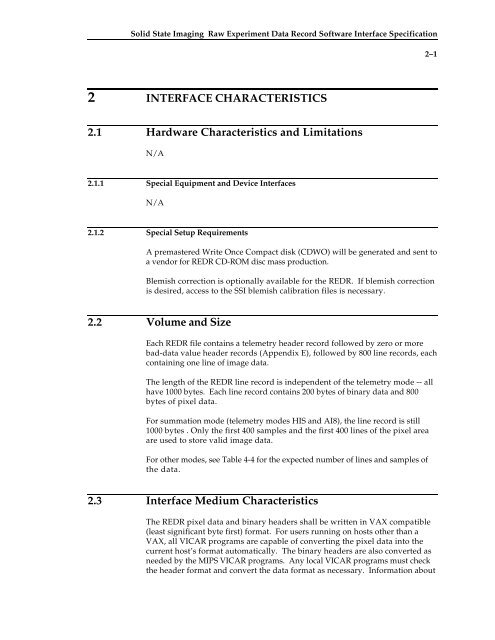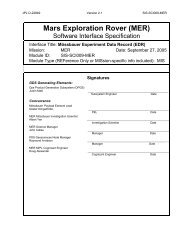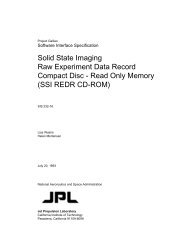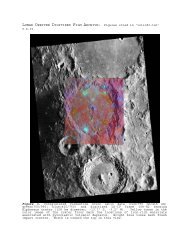SSI Raw Experiment Data Record (REDR) for Phase 2 - USGS PDS ...
SSI Raw Experiment Data Record (REDR) for Phase 2 - USGS PDS ...
SSI Raw Experiment Data Record (REDR) for Phase 2 - USGS PDS ...
You also want an ePaper? Increase the reach of your titles
YUMPU automatically turns print PDFs into web optimized ePapers that Google loves.
Solid State Imaging <strong>Raw</strong> <strong>Experiment</strong> <strong>Data</strong> <strong>Record</strong> Software Interface Specification<br />
2–1<br />
2 INTERFACE CHARACTERISTICS<br />
2.1 Hardware Characteristics and Limitations<br />
N/A<br />
2.1.1 Special Equipment and Device Interfaces<br />
N/A<br />
2.1.2 Special Setup Requirements<br />
A premastered Write Once Compact disk (CDWO) will be generated and sent to<br />
a vendor <strong>for</strong> <strong>REDR</strong> CD-ROM disc mass production.<br />
Blemish correction is optionally available <strong>for</strong> the <strong>REDR</strong>. If blemish correction<br />
is desired, access to the <strong>SSI</strong> blemish calibration files is necessary.<br />
2.2 Volume and Size<br />
Each <strong>REDR</strong> file contains a telemetry header record followed by zero or more<br />
bad-data value header records (Appendix E), followed by 800 line records, each<br />
containing one line of image data.<br />
The length of the <strong>REDR</strong> line record is independent of the telemetry mode -- all<br />
have 1000 bytes. Each line record contains 200 bytes of binary data and 800<br />
bytes of pixel data.<br />
For summation mode (telemetry modes HIS and AI8), the line record is still<br />
1000 bytes . Only the first 400 samples and the first 400 lines of the pixel area<br />
are used to store valid image data.<br />
For other modes, see Table 4-4 <strong>for</strong> the expected number of lines and samples of<br />
the data.<br />
2.3 Interface Medium Characteristics<br />
The <strong>REDR</strong> pixel data and binary headers shall be written in VAX compatible<br />
(least significant byte first) <strong>for</strong>mat. For users running on hosts other than a<br />
VAX, all VICAR programs are capable of converting the pixel data into the<br />
current host’s <strong>for</strong>mat automatically. The binary headers are also converted as<br />
needed by the MIPS VICAR programs. Any local VICAR programs must check<br />
the header <strong>for</strong>mat and convert the data <strong>for</strong>mat as necessary. In<strong>for</strong>mation about





